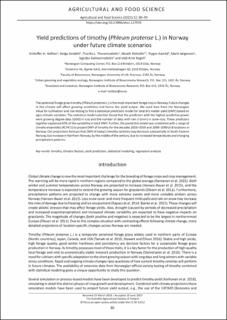| dc.contributor.author | Hellton, Kristoffer Herland | |
| dc.contributor.author | Amdahl, Helga | |
| dc.contributor.author | Thorarinsdottir, Thordis | |
| dc.contributor.author | Alsheikh, Muath K | |
| dc.contributor.author | Aamlid, Trygve S. | |
| dc.contributor.author | Jørgensen, Marit | |
| dc.contributor.author | Dalmannsdottir, Sigridur | |
| dc.contributor.author | Rognli, Odd Arne | |
| dc.date.accessioned | 2023-12-21T08:01:22Z | |
| dc.date.available | 2023-12-21T08:01:22Z | |
| dc.date.created | 2023-07-12T17:06:22Z | |
| dc.date.issued | 2023 | |
| dc.identifier.citation | Agricultural and Food Science. 2023, 32 (2), 80-93. | |
| dc.identifier.issn | 1459-6067 | |
| dc.identifier.uri | https://hdl.handle.net/11250/3108501 | |
| dc.description.abstract | The perennial forage grass timothy (Phleum pratense L.) is the most important forage crop in Norway. Future changes in the climate will affect growing conditions and hence the yield output. We used data from the Norwegian Value for Cultivation and Use testing to find a statistical prediction model for total dry matter yield (DMY) based on agro-climatic variables. The statistical model selection found that the predictors with the highest predictive power were growing degree days (GDD) in July and the number of days with rain (>1mm) in June–July. These predictors together explained 43% of the variability in total DMY. Further, the prediction model was combined with a range of climate ensembles (RCP4.5) to project DMY of timothy for the decades 2050–2059 and 2090–2099 at 8 locations in Norway. Our projections forecast that DMY of today’s timothy varieties may decrease substantially in South-Eastern Norway, but increase in Northern Norway, by the middle of the century, due to increased temperatures and changing precipitation patterns. | |
| dc.language.iso | eng | |
| dc.title | Yield predictions of timothy (Phleum pratense L.) in Norway under future climate scenarios | |
| dc.title.alternative | Yield predictions of timothy (Phleum pratense L.) in Norway under future climate scenarios | |
| dc.type | Peer reviewed | |
| dc.type | Journal article | |
| dc.description.version | publishedVersion | |
| dc.source.pagenumber | 80-93 | |
| dc.source.volume | 32 | |
| dc.source.journal | Agricultural and Food Science | |
| dc.source.issue | 2 | |
| dc.identifier.doi | 10.23986/afsci.127935 | |
| dc.identifier.cristin | 2162178 | |
| dc.relation.project | Norges forskningsråd: 303258 | |
| cristin.ispublished | true | |
| cristin.fulltext | original | |
| cristin.qualitycode | 1 | |
